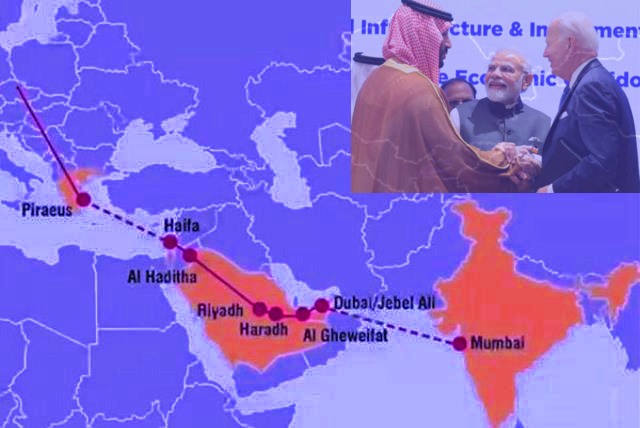The initial response was positive. Israel’s Benyamin Netanyahu called the India-Middle East-Europe Economic Corridor (IMEC) as the “largest cooperation project in history”. In a deft move, the United States dispatched its envoy to Pakistan to visit Gwadar Port, at the southern end of the rival China-Pakistan Corridor (CPEC). All applauded the MOU signed alongside the G20 summit, from Joe Biden to host Narendra Modi.
Undoubtedly, because it was floated by Biden, the idea was widely welcomed. The ceremony was attended by the leaders of Saudi Arabia, the UAE, the European Union, Italy, France and Germany. Everyone keen to ‘contain’ China joined what would now need a closer look and a coherent, collective follow-up.
Connecting an emerging powerhouse like India with Europe is a dream that has been nurtured for centuries. Linking it further across the Atlantic would be a win-win for all. But ifs and buts have cropped up way too soon about the feasibility of the nascent project.
While diplomatic analysts visualise numerous strategic and territorial obstacles, the economists find it is not feasible. Better and cheaper alternatives, are already available along the waterways or can be forged without cutting through mountains on the Arabian Peninsula to reach Greece, one of the weakest of European economies. All trade between India and Europe, anyway takes place via the sea route, passing through the Suez Canal. Questions arise about whether this corridor can better the Suez route or can attract more takers than the CPEC that it is widely perceived as competing with.
Unlike the BRI, which is aimed at securing China’s access to natural resources and building more direct trade and transport links among countries in Asia, Africa, Europe and the Middle East, IMEEC is much smaller in scale and so far, does not include African, Central Asian, Southeast Asian or other South Asian countries besides India.
The “new spice route” is a bridge too far. It is even a “bridge too late” and could duplicate the BRI’s effort. In its 10th year, BRI has seen more than 150 countries and upward of 30 international organizations sign cooperation agreements with China. The CPEC, its flagship, is also ten years old. Despite mutual disputes, slow and lopsided progress in Pakistan and security challenges for both, have at least met China’s objective of accessing the energy-rich Gulf. Assuming the IMPEEC takes off, its success will largely depend upon how many BRI members will be ready to switch to it to make it cost-effective.
ALSO READ: Belt Road Initiative – A Blessing or A Curse?
Undoubtedly, India stands to gain. For one, it can hope to circumvent the ‘wall’ of the volatile Afghanistan-Pakistan to reach West and Central Asia. But it has also to circumvent the objections, real or subtle, of its Western allies.
Take Chabahar Port which has languished because the Americans do not like Iran’s Ayatollahs. The US not only curbed the Indo-Iran ties but also scared away Japan and the ADB who were keen to invest in this corridor at one stage. The new corridor will require billions in consistent investment, over a long period to fructify and bring benefits to all participants.
At the diplomatic level, is a highly polarised world ready for it? Is the proposed corridor an American / Western response to China’s brokering peaceful ties between Riyadh and Tehran?
India has good ties with the Middle East and would need to stay neutral against the moves of those more powerful. The IMPEEC favours the UAE (Jebel Ali) and Israel (Haifa) but keeps out Egypt and Iran, two major players in the region. At the ground – or sea level — for India, loading-off-loading would mean multiple handling and container charges, among other levies, at every terminal and transhipment point.
At the political level, both Biden and Modi are looking at elections next year. Is the MOU a diplomatic harbinger for mutual political benefits? Modi is forever looking to consolidate his political domination to win a third term. Biden, while battling China in the global arena, needs to score a major point, especially after China took credit for the Saudi-Iran rapprochement in what was once an Anglo-American backyard. Although a Trump legacy, Biden has yet to live down the cumbersome evacuation from Afghanistan that has weakened the Western presence in the region.
As for India, to be able to see through a multi-billion project like the IMPEEC from its end, it has to constantly worry about its allies even more than its adversaries. The US/West have constantly pushed it to the defensive on human rights issues. Ukraine remains a major irritant, despite the G20 resolution, as India will continue to trade with Russia. Not strictly an ally, Turkey’s Erdogan, while at G20 lent qualified support to India getting a permanent place on the UN Security Council. But within days, he attacked India, yet again, on the Kashmir dispute.
Think of developments across this month. Emerging from the success of the G20 summit (and of its moon mission), India has been pilloried by these very allies in the new confrontation with Canada. Like Ukraine, this is not likely to go away anytime soon.
The world is informed daily of the counter-offensive against the Russians in Ukraine. The US-led alliance is keeping its war-like determination and its chin up. If it doesn’t produce the desired results, will “Ukraine fatigue”, like it had happened in Afghanistan, set in at some stage?
Beyond the initial official enthusiasm, it is not surprising to see a more considered response that underscores patience and the need to invest wisely in this long-term project. India has seen interest in many transnational projects like the Turkmenistan-Afghanistan-Pakistan-India (TAPI) gas grid rise and fade with shifting economic interests and changing strategic goalposts. Economists have already dampened the diplomats’ enthusiasm, for politicians to take note. Overall, it means putting the money where the mouth is.
The writer can be contacted at mahendraved07@gmail.com
